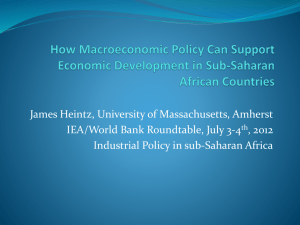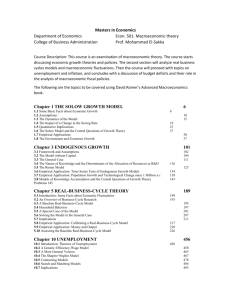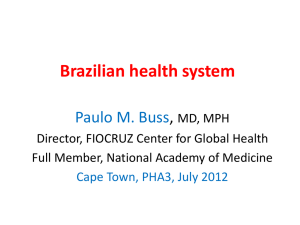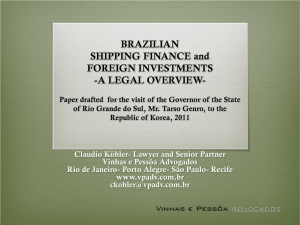Nonlinearities in Brazilian Yield Curve Joaquim Pinto de Andrade
advertisement
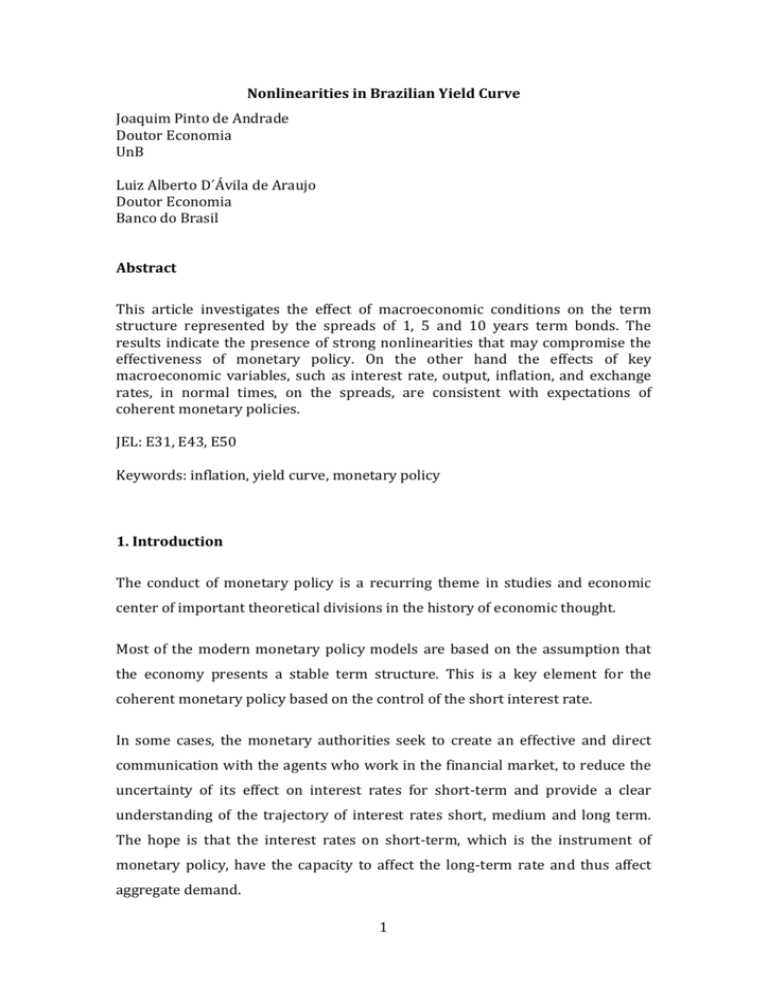
Nonlinearities in Brazilian Yield Curve
Joaquim Pinto de Andrade
Doutor Economia
UnB
Luiz Alberto D´Ávila de Araujo
Doutor Economia
Banco do Brasil
Abstract
This article investigates the effect of macroeconomic conditions on the term
structure represented by the spreads of 1, 5 and 10 years term bonds. The
results indicate the presence of strong nonlinearities that may compromise the
effectiveness of monetary policy. On the other hand the effects of key
macroeconomic variables, such as interest rate, output, inflation, and exchange
rates, in normal times, on the spreads, are consistent with expectations of
coherent monetary policies.
JEL: E31, E43, E50
Keywords: inflation, yield curve, monetary policy
1. Introduction
The conduct of monetary policy is a recurring theme in studies and economic
center of important theoretical divisions in the history of economic thought.
Most of the modern monetary policy models are based on the assumption that
the economy presents a stable term structure. This is a key element for the
coherent monetary policy based on the control of the short interest rate.
In some cases, the monetary authorities seek to create an effective and direct
communication with the agents who work in the financial market, to reduce the
uncertainty of its effect on interest rates for short-term and provide a clear
understanding of the trajectory of interest rates short, medium and long term.
The hope is that the interest rates on short-term, which is the instrument of
monetary policy, have the capacity to affect the long-term rate and thus affect
aggregate demand.
1
It has been the case in Brazilian economy that the risk of default due to
confidence and external demand shocks has raised the long term interest rate
independently of monetary policy. This is noteworthy during the currency crisis
of the year 1999 and election cycle expectations in the year 2002. In both cases
the short run interest rates jumped substantially without much effect on the long
run rates. During these events there is an indication that monetary policy was
endogenous, i.e. the long term may have affected the short term and not the
other way around.
The aim of this paper is to examine the role of macroeconomic variables in
determining the yield curve of the Brazilian economy.
Considering that the economy has suffered considerable confidence and external
demand shocks in recent decades the econometric methodology employed will
consider the presence of non-linear relationships between the variables.
This article is divided into four sections, besides this introduction, section 2
motivates the work showing the relationship between macroeconomic variables
and interest rates in the financial market, section 3 presents the smooth
transition regression model of the behavior of Brazilian interest rates and,
finally, section 4 presents the main conclusions.
2. Relationship between macroeconomic variables and interest rates in the
financial market
The study of the term structure of interest rates used to focus solely on the
behavior of demand and supply of bonds in the financial market, as an example
we can mention Merton (1973, p.163) and Vasicek (1977).
A new line of research attempts to identify the macroeconomic forces that affect
the movement of term structure. It analyzes, the role of the monetary authority
as influencing effectively and efficiently market expectations about the present
and future trajectory of interest, such as Diebold, Rudebusch and Aruoba (2006).
2
To clarify the statement of the preceding paragraphs, note that possible
explanations for the yield curve, particularly for movements in long-term rates,
have opposite implications for the conduct of monetary policy. These
explanations are, on the one hand a traditional analysis of the term structure of
interest centered on the risk premium and, secondly, a new chain that cares
about economic conditions and their effect on the interest rate path.
The possibility of substitution between bonds with different maturities ensures
arbitrage condition according to which the rate of return on these bonds is equal.
This condition is called by Campbell (1995) as the pure expectations hypothesis.
Accordingly the rate of return of a bond of n periods maturity is equal to the
average of current and expected rates of bonds of maturities of one period.
1
e
e
e
int » (i1t + i1t+1
+ i1t+2
+...i1t+n-1
) +e
n
i
Where nt corresponds to the rate of return of n periods bond, 𝑖1𝑡 is for the rate
of return of a one period bond. The spread is the difference between the longterm interest rate and current short-term interest rate as follows:
spread
1
(int i1t ) (i1et 1 i1t ) (i1et 2 i1t ) ...(i1et n 1 i1t )
n
If the market expects the rate of return on short-term securities rise in the near
future, then the long-term rate will tend to rise. The difference between the longterm rate and the short rate, i.e. the spread, can be considered as an
approximation of the slope of the yield curve. This means that the slope of the
yield curve depends on the behavior of short-term rates expected. The opposite
occurs when it is expected that the rate of return will be reduced in the short
term future.
It can be seen therefore that the role of expectations is key to determining the
rate of long-term return and consequently the spread.
In addition to the average of the short term of interest there is an additional
element to explain the long-term rate. The long-term bonds, as long as their face
3
value is only available over the future, are subject to risks, such as default and
inflation. Thus the yield of these bonds can embed a risk premium. This is
represented as the factor .
The objective of this work is to explain the behavior of spread by macroeconomic
conditions, through their effects on the short-term interest rates and on the risk
premium.
Stock and Watson (1989), Dombrosky and Haubrich (1995), Stock and Watson
(2001), Hamilton and Kim (2002), used the information of the term structure to
anticipate economic cycles.
Evans (1985) studied the effects of fiscal policy and showed that large deficits
affect interest rates of long and short term, changing the behavior of the yield
curve. In another study, Evans (1987) found that the announcement of deficit has
a temporary effect on short term interest rates.
In Brazil, Rocha, Moreira and Magalhães (2002) identified the importance of
foreign debt on the spread of foreign securities, Matsumura and Moreira (2005)
studied the importance of macroeconomic variables in the determination of the
spread.
The inclusion of macroeconomic variables followed in this work comes from
Diebold, Rudebusch and Aruoba (2006) that relates the level, slope and
curvature of the yield curve with macroeconomic variables: Capacity Utilization
installed (UC), Selic1, short-term interest ( itm ) and inflation rate ( t ).
3. Modeling the term structure of interest rates for the Brazilian economy
The models of the term structure exhibit nonlinearity as shown by Tabak and
Andrade (2001). The objective of this work differs, however, and it is not to
1
Interest rate is controlled by Banco Central do Brasil.
4
estimate the yield curve model but assess the importance of the macroeconomic
variables in the term structure represented by the spread.
The first aspect that can be observed in the behavior of the spread in the
Brazilian economy is the presence of substantial and rapid changes in the term
structure.
8.00
6.00
4.00
2.00
0.00
-2.00
-4.00
-6.00
-8.00
Spread1y
Spread5y
Spread10y
Figure 1: Spread of the Term Structure in Brazil.
The spread behavior in Brazil can be seen in Figure 1. We can observe that the
term structure of interest rates in Brazil does not present always a positive
slope. Abrupt changes in the spread are notorious reflecting possibly confidence
and demand shocks affecting the risk of default of public bonds. Note that the
spread of the 1 year, 5 years and 10 years bonds, present negative values in
some years.
Thus, the Brazilian economy displays some characteristics that may indicate the
presence of non-linearity (regime change) in the term structure.
The model used is based on the idea of "threshold", the dependent variable is a
function of the independent variables in a peculiar way: the dependent variable
is described by a linear process to a certain threshold, from which the coefficient
of the variables changes.
The "threshold" approach is based on Hansen (2000), which provided the
possibility to split the sample and use an indicator function with observable
5
variables. The "threshold" variable has its use linked to the division of the
sample into subgroups that can be considered as classes or arrangements of
economic policy.
Teräsvirta (2007) showed that nonlinear models have gained importance in
macroeconomics and financial modeling. Among the categories of nonlinear
models it is well known the Switching, Markov-switching and the Smooth
Transition Regression (STR) models. The STR model can be seen as an evolution
of switching regression model.
The typical STR model is defined as:
yt G , c, st zt ut
/
(1)
Where z t wt/ , xt/ is a vector of explanatory variables that contains a vector of
lags of the dependent variable wt/ 1, yt 1 ,, yt p and a vector of exogenous
/
variables xt x1t ,, xkt . Note that j is the vector of parameters of the linear
/
part and q is the parameter vector of the non linear.
The transition function G , c, st has a slope parameter , a vector of location
parameters c , where c1 ck , and a limit s t . The transition function is a
logistic of the general type:
1
K
G , c, st 1 exp st ck , 0
k 1
(2)
Where g > 0 is a constraint for identification.
The estimated model for the Brazilian economy follows the equation (1) where
𝑦𝑡 = 𝑆𝑝𝑟𝑒𝑎𝑑 and zt is the vector containing the exogenous macroeconomic
variables zt RBrazil t UCIt
Selic t
IPCAt and
variable wt y t 1 .
6
the
lagged
dependent
Note that the linearity is tested against a STR model with transition variable
predetermined. As the theory does not specify the transition variable, the test is
repeated for each variable in the set of potential transition variables. Thus, the
model STR has the property of being identified under the alternative hypothesis,
instead of the null hypothesis of linearity.
When 0 we have the transition function G , c, st 1 / 2 and the model is
linear. Otherwise, being nonlinear, we have to choose K restricted to K = 1 or
K = 2. For K = 1, the parameters G , c, st change monotonically as a
function of s t from up to . For K = 2, they change symmetrically around
the midpoint c1 c2 / 2 , where the logistic function reaches its minimum value.
The minimum value is between zero and ½, reaching zero when and ½
when c1 c2 e . The parameter g controls the tilting and c1 e c2 provide
the location of the transition function.
Similarly to the linear models, in STR have to reduce their size by elimination of
redundant variables in yt G , c, st zt ut .
3.1 Estimation of the Smooth Threshold Model – STR
The database used contains monthly data for the period August 1997 to
September 2011 (169 observations). The historical series of transactions of
Future Pre x DI were obtained from the BM&F and were used for the
construction of the term structure of interest rates; the capacity utilization of the
Brazilian industry (UCI) in the last twelve months was obtained from the
National Confederation of Industry - CNI; the rate of inflation measured by the
National Index of Consumer Prices (IPCA) for 12 months was obtained from the
IBGE and the Selic rate was obtained from the Central Bank of Brazil. The
evolution of the EMBI + Brazil (Emerging Markets Bond Index) was obtained
from Bloomberg and corresponds to RBrazil.
7
Considering the assumptions of economic theory some results are expected.
Inflation (IPCA) is expected to have a positive effect on the interest rate term
structure, due to the risk of inflation embedded in the yield curve. Besides this
risk premium there is yet another element which is the expected increase in
short term interest rates bonds driven by the monetary policy. Both factors tend
to reinforce the positive effect of inflation on the long-term interest rate.
The coefficient of the annualized overnight rate of interest (Selic), in the spread
equation depends on market expectations. If market believes that the increase in
the Selic rate is permanent the effect on the long term rate will be close to one
and so will not affect significantly the spread. This result is crucial for the
effectiveness of monetary policy. When the coefficient is equal or greater than
zero it means that the Selic rate changes will affect the long-term rate in equal or
greater measure. However, when an increase in the Selic is understood by the
market as a temporary the effect on the long-term rate will be small and the
spread will fall. In this sense it is important to analyze the sign and value of the
coefficient of the Selic rate in the spread equation.
The level of capacity utilization (UCI) is the ratio of the volume produced and
the ceiling that the machines and equipment are able to produce. It can be
considered as a proxy for the output gap. It is important to note that a positive
sign may indicate increase in expected short term interest rates (long-term yield
curve). This can be understood as the expected response of the monetary
authorities that dislike inflation threats.
Something similar can happen from the devaluation of the exchange rate
(Dollar). An increase in the exchange rate indicates an improvement in export
competitiveness leading to future expansion. Another possibility is that
devaluation may signal a future tightening of liquidity. In both cases an increase
of the short term interest rates is expected. This means a positive coefficient of
exchange rate on spread.
To pursue the empirical research on the Brazilian term structure, based on the
smooth transition regression model, STR, it is necessary to identify which is the
8
variable responsible for regime changes and what are the signs and magnitudes
of the effects of macroeconomic and financial variables to explain movements in
spreads measured by 1, 5 and 10 years bonds.
STR model is estimated using the conditional maximum likelihood, through the
software Multi-J.
The specification began with a linear model suggested by Diebold et al (2006)
including two additional variables, the exchange rate (Dollar), which accounts
for the Brazilian dependence on foreign trade, and the so called Brazil Risk
(RBrazil) as proxy for dependence on international capital. RBrazil is the level of
country risk measured by the EMBI + Brazil2, the higher is the price index of this
bundle of assets the higher is the risk perception by the international financial
market of the directions of the Brazilian economy.
The specification of the models was parsimonious, considered the problems of
autocorrelation
and
heteroscedasticity
in
residuals,
and
obeyed
the
minimization of the Akaike information criterion (AIC), Schwarz (SC) and
Hannah-Quinn (HQ).
Using the usual tests for unit root in particular the DF-GLS test of Elliott,
Rothenberg and Stock, the existence of unit root was rejected for all variables
except the nominal exchange rate, Brazil Risk and the rate of inflation measured
by IPCA. These variables, that presented unit root, were considered in first
differences.
The next step is to apply econometric tests that seek to ensure the correct
specification of the model. Accordingly, the first step is to test for the existence or
non-linearity of the estimated model. If linearity is rejected, the choice is the
correct value K (K = 1 or K = 2). Table 1 indicates that the model is non-linear and
corresponds to the smooth logistic regression model LSTR1 with transition
variable defined as the RBrazil.
The EMBI + Brazil measure the price movement of securities from one day to the other. Its unit is the base
point, i.e. 500 basis points imply that Brazilian bonds pay 5% more than the U.S., considering periodic
interest payments, purchase price, redemption value and the time remaining until maturity obligations, is
used by domestic and international investors
2
9
Table 1: Linearity Test against STR.
p-values of F-tests (NaN - matrix inversion problem):
transition variable
F
F4
F3
RBRAZIL_d1(t)*
4.29E-42
2.44E-04
2.87E-03
RBRAZIL_d1(t)*
2.72E-20
2.67E-01
9.79E+00
RBRAZIL_d1(t)*
7.35E-18
2.75E+00
4.65E-04
F2
2.60E-34
2.23E-17
3.09E-10
suggested model
LSTR1
LSTR1
LSTR1
term model
Spread1y
Spread5y
Spread10y
The grid was calculated, indicating the value of the variable range that
represents the type of gradient vector and the location represented by the
variable c1 whose results are detailed in Table 2.
Table 2: Grid.
SSR
34.1199
72.7187
97.2578
gamma
0.5000
3.5593
4.8524
c1
129.8276
24.7241
24.7241
term model
Spread1y
Spread5y
Spread10y
transition function: LSTR1
grid c
{-711.00, 813.00, 30}
grid gamma
{ 0.50, 10.00, 30}
transition variab le: RBRAZIL_d1(t)
Having the specification of the model, in the case LSTR1, the transition variable
RBrazil, the variable grid that is c {-711.00, 813.00, 30} and the function that
corresponds to the range {0, 50, 10,00, 30}, it is possible to run the estimation
algorithms and, through an iterative process, to estimate the nonlinear model to
evaluate the behavior of the yield curve.
The tests for heteroscedasticity and autocorrelation of the residuals are shown
in Tables 3 and 4.
The test for absence of autocorrelation corresponds to the applied test used by
Teräsvirta (1998) and corresponds to a special case of the general test
Godfrey (1988). The procedure corresponds to regress the estimated residuals
on the lagged ones and on the partial derivatives of the log -likelihood function
with respect to the parameters of the model. The detailed results, in Table 3,
show the null hypothesis of no autocorrelation of the estimated residuals of the
models for spreads of 1, 5 and 10 years.
Table 3: Model Specification - Testing Absence of Correlation.
10
lag
1
2
3
4
5
Spread1y
F-value
p-value
0.2725
0.6024
0.7404
0.4788
1.2295
0.3014
1.2036
0.3121
1.0066
0.4163
Spread5y
F-value
p-value
0.1826
0.6698
0.1149
0.8915
0.0543
0.9833
1.7990
0.1325
1.7496
0.1275
Spread10y
F-value
p-value
0.1098
0.7408
0.2759
0.7593
0.2847
0.8364
0.6269
0.6441
1.0545
0.3885
The test of Heteroscedasticity corresponds to the ARCH-LM test that represents
a similar statistics to that described by Doornik and Hendry (1997), centered on
a multivariate LM statistics. Table 4 shows that the null hypothesis of
homoscedasticity of the residuals was not rejected for models estimated for
terms of 1 and 10 years. For the term of five years, there is some probability of
incurring in this type of problem.
Table 4: Model Specification - Test of Heteroscedasticity.
lag
1
2
3
4
5
Spread1y
F-value
p-value
0.2725
0.6024
0.7404
0.4788
1.2295
0.3014
1.2036
0.3121
1.0066
0.4163
Spread5y
F-value
p-value
0.1826
0.6698
0.1149
0.8915
0.0543
0.9833
1.7990
0.1325
1.7496
0.1275
Spread10y
F-value
p-value
0.1098
0.7408
0.2759
0.7593
0.2847
0.8364
0.6269
0.6441
1.0545
0.3885
The proper fit of the model to estimate Spread of 1 year is suggested in figure 2,
when it is shown the almost imperceptible difference between the original series
and the series adjusted by linear and nonlinear components.
Figure 2: Set the STR model for the spread of 1 year.
11
The version of the STR model estimated is a generalization of the standard
autoregressive model where the autoregressive coefficient is a logistic function,
where G , c, st 1 exp RBrazil t ck , 0 . Note that 𝛾 is the
k 1
smoothing parameter. For the spread of 1 year, 5 years and 10 years, 𝛾 values
found were 0.4986, 3.4501 and 4.7852, respectively, noting that the higher the
value of 𝛾 sharper is the S shape of the transition variable.
Analyzing the behavior of the transition function - the logistic type, it is
considered a range of -800 to +1,000 points of variation in risk Brazil (RBrazil)
and varying values 0 to 1 of the function G. It is notorious the S shape of the
transition for the highest values of γ for the spreads of 5 and 10 years, as shown
in Figure 3.
Figure 3: Values of γ (gamma) in the model LSTR.
Brazilian economy has suffered in the last two decades severe shocks of
confidence that affected mainly the foreign currency and long term government
bonds. The variable chosen to define the transition and the threshold for the non
linear model is the RBrazil.
It satisfies the tests as transition variable accordingly, as explained earlier. Note
that RBrazil is measured by the weighted average of the Brazilian securities
traded abroad in relation to securities of the same characteristic of the United
12
States government and as such it is a very good proxy of country risk. It may
affect directly the interest of the long term bonds; however its main importance
is in explaining the main shifts of the whole term structure. The estimated
thresholds of the change of the RBrazil are 150.90, 41.34 and 32.88 for the
spreads of 1, 5 and 10 year bonds respectively (see Table 5 below).
Its
relationship with the non linear behavior of the term structure is illustrated in
the Figure 4 that presents the dRBrazil (first differences of RBrazil), and the
spreads of 1 and 10 year bonds.
1,000
8.00
800
6.00
600
4.00
400
2.00
200
0.00
0
-2.00
-200
-4.00
-400
-600
-6.00
-800
-8.00
dRBRAZIL
Spread1y
Spread10y
Figure 4: Risk Brazil vs. Spread.
3.2 Main Results of the Econometric Experiment
The estimation of the spread of the term structure of interest rates support the
conclusion of Diebold, Rudebusch and Aruoba (2004) and it indicates that
macroeconomic variables have significant explanatory power for the volatility of
the spread of the term structure of interest rates observed in the Brazilian
financial market.
The importance of the spread of the previous period in the formation of the
spread of the current period is positive and significant in all three terms
13
analyzed (1, 5 and 10 years), as can be seen in the linear part of the estimates
described in Table 5. The coefficient reduces by half when the term goes from 1
to 5 and 10 years, being 1.34, 0.77 and 0.72 respectively. It means that the
memory of short term maturity (1 year) tends to increase volatility while longer
term maturities (5 and 10 years) tend to smooth the spreads.
variable
----- linear part -----CONST
Spread(t-1)
Selicef(t)
DOLLAR_d1(t)
UCI(t-1)
DOLLAR_d1(t-1)
IPCA_d1(t-2)
IPCA_d1(t-3)
RBRAZIL_d1(t-4)
UCI(t-4)
---- nonlinear part
CONST
Spread1y(t-1)
Selicef(t)
DOLLAR_d1(t)
UCI(t-1)
DOLLAR_d1(t-1)
IPCA_d1(t-2)
IPCA_d1(t-3)
RBRAZIL_d1(t-4)
UCI(t-4)
Gamma
C1
AIC:
SC:
HQ:
R2:
adjusted R2:
variance of transition variable:
SD of transition variable:
variance of residuals:
SD of residuals:
Spread1y
estimate
p-value
Spread5y
estimate
p-value
Spread10y
estimate
p-value
-83.7388
1.3418
-0.3016
0.9699
1.4277
ND
ND
1.4493
0.0014
-0.3217
0.0245
0.0000
0.0064
0.1977
0.0306
ND
ND
0.0348
0.1709
0.2129
2.2772
0.7730
-0.1777
1.6954
0.2501
3.2809
ND
0.6726
ND
-0.2462
0.7184
0.0000
0.0000
0.0448
0.0222
0.0000
ND
0.0000
ND
0.0100
7.1330
0.7275
-0.1831
1.9795
0.1982
4.1788
0.6865
ND
ND
-0.2531
0.2871
0.0000
0.0000
0.0383
0.0856
0.0000
0.0002
ND
ND
0.0132
222.9099
-1.5372
0.7323
3.4834
-3.8294
ND
ND
-3.6467
-0.0073
0.9007
0.4986
150.9090
-1.3508
-1.0105
-1.2126
0.8597
0.8606
25729.2447
160.4034
0.2336
0.4834
0.0111
0.0213
0.0164
0.0583
0.0101
ND
ND
0.0398
0.0124
0.1276
0.0121
0.2086
17.5635
0.1801
0.4788
-2.0169
-0.8453
-2.0298
ND
-1.3018
ND
0.5488
3.4501
41.3459
-0.6080
-0.2678
-0.4699
0.8835
0.8842
25729.2447
160.4034
0.4910
0.7007
0.3339
0.1010
0.0000
0.1176
0.0013
0.1422
ND
0.0005
ND
0.0117
0.0000
0.0021
11.8492
0.2002
0.4661
-2.2947
-0.7373
-2.2711
-1.1850
ND
ND
0.5154
4.7852
32.8777
-0.3082
0.0320
-0.1701
0.8888
0.8894
25729.2447
160.4034
0.6627
0.814
0.5253
0.0273
0.0000
0.0988
0.0074
0.1457
0.0040
ND
ND
0.0204
0.0000
0.0013
transition function: LSTR1
sample range: [1998 M2, 2011 M9], T = 164
Models: Spread1y(t) = CONST Spread1y(t-1) Selicef(t) DOLLAR_d1(t) UCI(t-1) IPCA_d1(t-3) RBRAZIL_d1(t-4) UCI(t-4)
Spread5y(t) = CONST Spread5y(t-1) Selicef(t) DOLLAR_d1(t) UCI(t-1) DOLLAR_d1(t-1) IPCA_d1(t-3) UCI(t-4)
Spread10y(t) = CONST Spread10y(t-1) Selicef(t) DOLLAR_d1(t) UCI(t-1) DOLLAR_d1(t-1) IPCA_d1(t-2) UCI(t-4)
Table 5: Model STR Estimate.
The short term interest rate Selic rate presented significant negative coefficient,
as observed in the linear part, an indication of a temporary impact on CDI's
financial market. However, in the non-linear estimation, the signal is positive,
indicating that the increase in the Selic rate has a positive effect on long term
rates. In other words, the negative effect on the spread of the Selic is cushioned
14
and may even become positive in the periods that the Brazil risk exceeds the
threshold. This may indicate that agents expect the Selic rate will continue
increasing in the future to circumvent the impact of shocks.
The exchange rate (U.S. dollars) had the expected positive sign, indicative of
improved export competitiveness or devaluation involving a tightening of
liquidity, both indicating increased rate of long-term (increased interest rate of
short- expected term).
The analysis of the inflation rate is important because it is associated with the
influence the yield curve through the inflation risk premium. The expected result
of a positive effect is observed, but for longer terms the effect is reduced
substantially, reflecting possibly the credibility of the Brazilian monetary
authorities to control inflation. An alternative interpretation, however, is that an
increase in inflation indicates that the central bank will gradually increase the
rate of short-term interest. On the non-linear behavior there is a negative
cushioning effect as before.
The coefficient of capacity utilization of the Brazilian industry presented a
positive coefficient in the linear part, showing that the yield curve has a behavior
attached to the cyclical dynamics of the Brazilian economy
Brazil risk is extremely relevant as the transition variable establishing the
threshold of the non linear behavior of the Brazilian financial market. Its
relevance to explain the level of the spread in the nonlinear part of the model is
noteworthy. That may explain why its contribution as an additional variable
within the equation is weak.
4. Conclusion
The study of the term structure of interest rates and the behavior of the term
spread, the difference between long-term rates minus the short term, has
puzzled monetary policy researchers, because not always is the expected effect
15
of the actions of the monetary authority on long rates prevailing in the financial
market.
The presence of strong nonlinearity in the term structure largely explains the
pitfalls of monetary policy. That is, the lack of effectiveness of this policy in
certain periods, particularly in those with non-linear behavior.
The positive correlation of inflation with the spread, is coherent with growing
uncertainty, but also seems to indicate that the financial community believes in
the monetary policy of the Central Bank. The same happened with the rate of
capacity utilization and exchange rate.
Last but not least it is possible to consider that inflation rate, capacity utilization
and exchange rate could be taken as proxies for the future expansionary cycles
and in that sense the spread could be considered as a predictive factor of future
expansion. This, however, shall be object of a new research.
Therefore, the Brazilian economic policymakers must watch the movements of
the yield curve and analyze the information frequently, to guide the analysis and
actions to be taken, to interfere in a beneficial way on the trajectory of the
Brazilian economy.
16
References
[1] Bernanke, B. S. (1983). "Nonmonetary Aspects of the financial crisis in the
propagation of the great depression", The American Economic Review, vol. 73, p.
257-276.
[2] ________ (1990). "On the predictive power of interest rates and interest rate
spreads," New England Economic Review, Federal Reserve Bank of Boston, p. 5168.
[3] Campbell, J. Y. (1995). "Some lessons from the yield curve," Journal of
Economic Perspectives, vol. 9, no. 3, p. 129-152.
[4] Diebold, Francis X. & Rudebusch, Glenn D. & Boragan Aruoba, S. (2006). "The
macroeconomy and the yield curve: a dynamic latent factor approach," Journal of
Econometrics, Elsevier, vol. 131 (1-2), pages 309-338.
[5] Doornik, J. A. and Hendry, D. F. (1997). Modelling Dynamic Systems Using
PcSiml 9.0 for Windows, International Thomson Business Press, London.
[6] Evans, P. (1985). Do Large Deficits Produce High Interest Rates? The
American Economic Review, 75 (1), 68-87.
[7] Evans, P. (1987). Interest Rates and Expected Future Budget Deficits in the
United States. The Journal of Political Economy, 95 (1), 34-58.
[8] Godfrey L. (1988). Misspecification Tests in Econometrics, Cambridge
University Press, Cambridge.
[9] Hamilton, James D. and H. Dong Kim (2002). A Re-Examination of the
Predictability of the Yield Spread for Real Economic Activity. Journal of Money,
Credit, and Banking, 34, 340-60.
[10] Hansen, B. E. (2000). Sample splitting and "threshold" estimation.
Econometrica, vol. 68, no. 3, 575-603.
17
[11] Haubrich, Joseph G. and Ann M. Dombrosky (1996). Predicting Real Growth
Using the Yield Curve, Federal Reserve Bank of Cleveland Economic Review, vol.
32, no. 1 (one quarter 1996) p. 26-35.
[12] Matsumura, M. and A. Moreira (2005). Macroeconomics Variávels Can
Account for the Structure of Sovereign Spreads? Studying the Brazilian Case.
IPEA Discussion Paper No. 1106.
[13] Merton, R (1973). The Theory of Rational Option Pricing, Journal of
Economics and Management Science 4, p. 141-183.
[14] Rock, K., Moreira, A. and R Magalhães (2002). Determinants of Brazilian
Spread: A Structural Approach. IPEA Discussion Paper No. 890.
[15] Stock, James H. and Mark W. Watson (1989). New Indexes of Coincident and
Leading Economic Indicators, in Olivier Blanchard and Stanley Fischer, NBER
Macroeconomics Annual, Cambridge MA: MIT Press.
[16] ________ (2001). "Forecasting Output and Inflation: The Role of Asset Prices,"
NBER Working Papers 8180, National Bureau of Economic Research.
[17] Tabak, B. and Andrade, S. (2001). Testing the expectations hypothesis in the
Brazilian term structure of interest rates. Brasília: Banco Central do Brazil
Working Paper nr. 30.
[18] Teräsvirta, Thymus (1998). Modeling economic relationships with smooth
transition regressions, in A. Ullahe D. Giles (eds), Handbook of Applied Economic
Statistics, Dekker, New York, p. 229-246.
[19] ________ (2007). Smooth Transition Regression Modeling. Themes in modern
econometrics: Applied Time Series Econometrics, ch. 6, 222-242, Cambridge
University Press.
[20] Vasicek, O. (1977). An Equilibrium Characterization of the Structure Term.
Journal of Financial Economics 5, p. 177-188.
18

